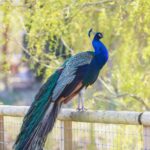If you live in Florida or have visited, you will no doubt have noticed that there are wild peacocks roaming Florida.
Peacocks are male peafowl, and the females are called peahens. Just to be clear, there are both peacocks and peahens living in Florida.
When peacocks are living in residential areas, some residents enjoy having them, some are indifferent, and some people absolutely hate them.
Whatever your feelings are on the matter, the history of how peacocks came to be living across Florida is interesting.
Table of Contents
Are There Wild Peacocks in Florida?
There are thousands, maybe even tens of thousands of wild peafowl living across Florida.
They’ve even become quite the tourist attraction in some areas like Harbor Heights and Orange County due to their exotic nature and beautiful tail displays.
While peacocks are almost always a welcome sight for tourists - if there are wild peacocks where you live it’s often a different story.
Peafowl are beautiful birds, but we have to remember that they’re wild birds and native to forestry areas.
They’re not designed to live in close proximity with humans.
Peafowl can be noisy, especially if it’s breeding season. Few people want to hear that distinctive loud, high-pitched screech early in the morning.
They can also cause a lot of damage to personal property, poop everywhere, and can be quite intimidating.
Why Are There So Many Peacocks in Florida?
Although there are peacocks living wild all across the states, peafowl are not native to the US.
There are a few different species of peafowl, and they’re generally native to Africa, India, and Southeast Asia.
The terrains where peacocks are from are desert areas, rainforests, and areas that are generally dense with foliage where they can hide from predators, roost, and find plenty to eat.
It’s never really known exactly how or why peafowl became wild in Florida, or most of the US states for that matter.
The best - and the most likely - guess is that peafowl escaped from captivity. Either being kept as pets, or living on large grounds like parks, or public attractions.
For example, I was able to find a news article that thinks some of the wild peacocks in Tampa Bay will have come from the closing of Seville Peacock Farm many decades ago.
Whatever their origin, what we do know is that peafowl are very adept at surviving in the wild.
With a source of food and few predators, they will generally populate in numbers without too much difficulty.
Related - More on wild peacocks living in Georgia, Michigan, and California.
Are Peacocks Protected In Florida?
Peacocks are not protected by federal laws, but they are protected under state animal cruelty laws under the Florida Statute.
No matter how much of a nuisance peacocks or peahens are to you, you absolutely should not take matters into your own hands.
The law states that you can receive a fine of up to $5,000 and/or up-to a year in prison if you’re found guilty of shooting a peacock.
If you torture or harm a peacock you face sentencing as harsh as up to 10 years behind bars, and a fine of up to $10,000.
If you’re being bothered by wild peacocks, contact your local office or pest control and find out what the correct channels are to find a solution where you live.
What Kind of Peacocks Are in Florida?
There are three main species of peafowl:
- Indian blue peafowl
- Green peafowl which is also called the Indonesian peafowl, and
- Congo peafowl which is also called the African peafowl
The Green peafowl is native to Southeast Asia and is listed as being endangered. The Congo peafowl is from the Congo in Africa and is listed as vulnerable by the IUCN.
It’s the Indian blue peafowl that is commonly found all over the world. This is the kind of peacock roaming Florida and is easily identifiable by its blue and green feathers.
Indian peafowl are omnivores and will eat just about anything they can get a hold of from bugs and insects, to plants and scraps from human foods.
Related - A closer look at laws protecting peafowl in Florida.
Are Peacocks Invasive in Florida?
Peacocks are an invasive species, generally speaking. If you’ve come across them in Florida I’m sure you’ll agree with this statement.
Peafowls tend to go about their business and aren’t too bothered by humans. If they see something they want to eat or investigate, they’re usually bold enough to take a closer look.
When they’re living in built-up areas, peacocks will help themselves to anything edible in yards and gardens, and that’s part of the problem.
It can be hard to read a peacock’s body language, too. When they’re spreading their tail feathers, it can be a sign of courtship - as well as a warning sign that they feel threatened.
The best advice is to not approach peafowl. Admire them from afar, and if they’re on your property shoo them away from a distance!
In Summary
There are a lot of wild peacocks in Florida. Peafowls living in Florida are both a tourist attraction and a feature in certain districts - and a nuisance to numerous residents that live with them day to day.
As a resident, it’s important that you know you can’t lawfully take matters into your own hands if they’re damaging your property.
You’ll need to call your local office for advice on how you can get them removed from your area legally and humanely.
As a tourist or someone who’s interested in seeing these magnificent birds, there’s certainly no shortage of peafowl to enjoy in the state of Florida!
Resources
Image credits - Photo by Hans Veth on Unsplash




